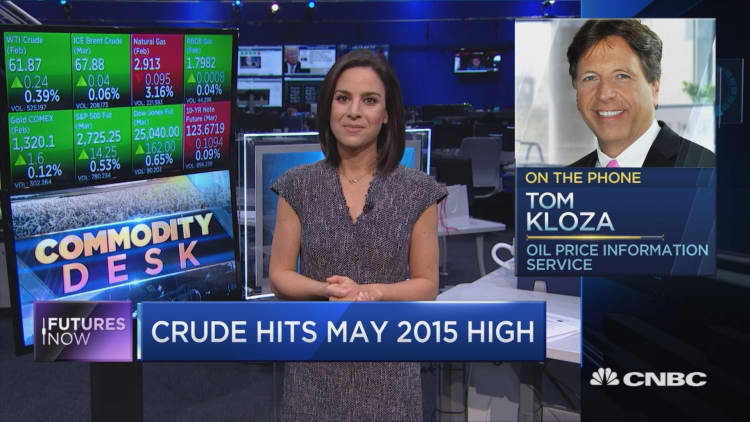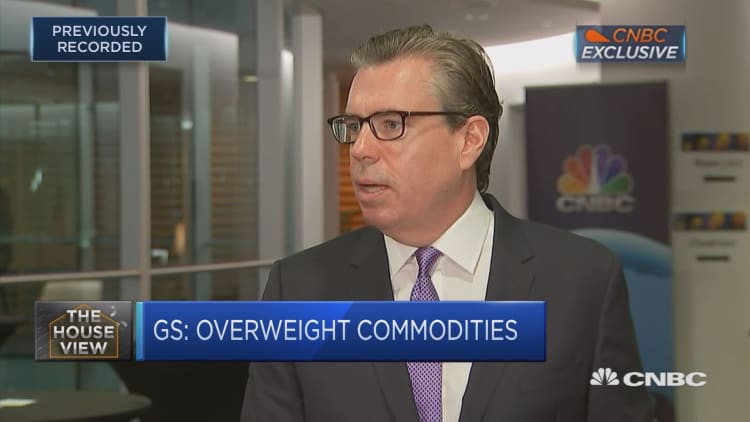U.S. crude oil rose to its highest level in more than three years on Tuesday, supported by OPEC-led production cuts and expectations U.S. crude inventories fell for an eighth week.
The Organization of the Petroleum Exporting Countries and allies including Russia are keeping supply limits in place in 2018, a second year of restraint, to reduce a price-denting glut of oil held in inventories.
U.S. crude futures rose to $63.19 a barrel, their highest level since Dec. 10, 2014, when they hit $63.43. The contract ended Tuesday's session up $1.23, or 2 percent, at $62.96.
Brent crude, the international benchmark, touched $69.08, its highest level since May 2015.
"Oil prices remain on an upward trajectory," said Carsten Fritsch, analyst at Commerzbank.
"In view of sharply falling U.S. crude oil stocks and record-high compliance with the production cuts by OPEC, market participants are convinced that the market is continuing to tighten."

OPEC is cutting output by even more than it promised and the restraint is reducing oil stocks globally, a trend most visible in the United States, the world's largest and most transparent oil market.
"We expect oil demand growth to outpace non-OPEC supply growth in both 2018 and 2019," Standard Chartered analysts said in a note.
"In our view, the back of the Brent and WTI curves are both still underpriced. We do not think that prices below $65 per barrel are sustainable into the medium term."
Supply reports this week from industry group American Petroleum Institute and the U.S. government's Energy Information Administration are expected to show U.S. crude stocks fell by 4.1 million barrels, an eighth week of decline.
The API releases its data at 4:30 p.m. ET (2130 GMT) on Tuesday and the government report is out on Wednesday.
"You're so long this market at this point, you could certainly get more interest at these levels," said Rob Haworth, senior investment strategist at U.S. Bank Wealth Management.
"This is a little more confirmation of what speculators have been looking for and after tomorrow's (U.S. government inventory) report, we'll see if they look to do some profit taking."
Many producers, still suffering from a 2014 price collapse, are enjoying the rally, although they are wary it will spur rival supply sources. Iran said on Tuesday OPEC members were not keen on increased prices.

The rise in prices is expected to drive gains in U.S. production during 2018, offsetting curbs by others.
U.S. crude oil production is expected to climb to more than 10 million barrels per day (bpd) early in 2018, reaching that milestone for the first time since 1970, and to continue to surge into 2019 to a record high at over 11 million bpd, the EIA said in its first outlook for next year.
Some analysts have said a potential rise in U.S. shale oil production could discourage OPEC and Russia to maintain their deal to curb supply until the end of the year for fears of losing market share.
"I am now on the lookout for bearish technical patterns to emerge on oil prices as I believe they will struggle to go north of $65-$75 per barrel given the above fundamental consideration," said Fawad Razaqzada, technical analyst for Forex.com.
"If WTI were to go back below the 2017 high of $60.48, which was hit late in the year, and the 2018s opening price of $60.09, then the technical outlook would turn bearish on oil. But for now, the bullish trend remains intact as prices remain above key supports."
— CNBC's Tom DiChristopher contributed to this report.

